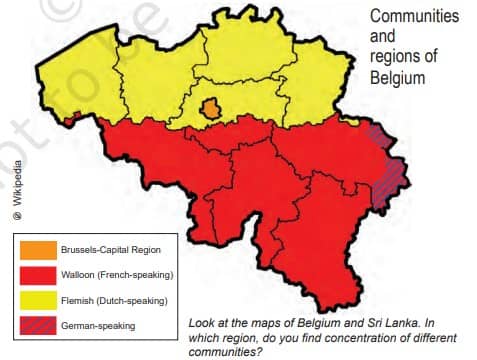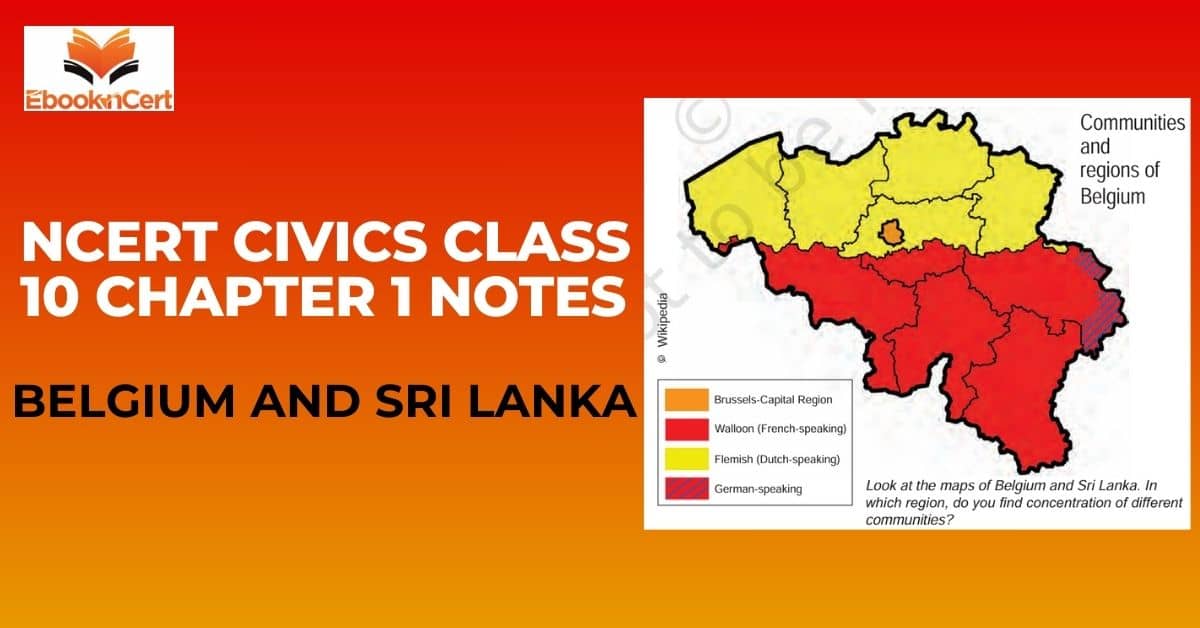Belgium and Sri Lanka Class 10 – Concept & Notes PDF
Topic & sub-topics covered: Belgium and Sri Lanka and MCQs Questions: Power-sharing (All single detail notes are exam-oriented).
We have discussed in-depth and exam-oriented pointers that can be asked in the board exam of class 10th about “Belgium and Sri Lanka” from the NCERT Political Science (Civics) notes for class 10th chapter 1 “Power-sharing“.
Download the NCERT Political Science (Civics) for Class 10 Chapter 1 Power-sharing PDF Notes
Are you preparing for your Class 10 exams and looking for the best & exam-oriented notes? Look no further than E-bookncert.com! Download the NCERT Political Science (Civics) for Class 10 Chapter 1 Power-sharing PDF Notes to gain a good understanding of one of the most important chapters in your board exam syllabus.
NCERT Civics (Political Science) Class 10th Chapter 1 – Power Sharing Notes & MCQ’s Question-Answer
This chapter explains the concept of power-sharing in a democracy, its necessity, and various forms through real-life examples from countries like Belgium and Sri Lanka, Majoritarianism in Sri Lanka, Accommodation in Belgium, Khalil’s Dilemma, and Forms of Power-sharing.
Visit the E-book NCERT to download the NCERT Political Science (Civics) for Class 10 Chapter 1 Power-sharing PDF Notes. Prepare for your board & school exam with our notes that will help you understand the concepts and boost your understanding and mark in exams.
Overview On Power Sharing
Introduction to Power Sharing
1. Continuation of Democracy Study:
- This chapter builds upon the study of democracy from the previous year.
2. Distribution of Power in Democracy:
- No single organ (Legislature, Executive, Judiciary) holds all power.
- Intelligent sharing of power is essential for democracy.
Case Studies on Power Sharing
1. Stories from Belgium and Sri Lanka:
- These countries demonstrate different approaches to power-sharing.
- The cases highlight challenges in accommodating diverse social groups.
2. Lessons from Belgium and Sri Lanka:
- Help understand how democracies handle power-sharing demands.
- Show the importance of inclusive governance in a democracy.
Significance of Power Sharing
1. Key Takeaways on Power Sharing:
- Essential for maintaining democracy and preventing conflicts.
- Ensures representation and participation of all communities.
2. Forms of Power Sharing (Explored in Future Chapters):
- Different models of power-sharing will be discussed in detail in the next two chapters.
Overview of Belgium and Sri Lanka

1. Resuming the Tour of Democracy:
- Continuation from the previous year’s exploration of democracy.
- Focus on the concept of power-sharing in a democratic system.
2. Core Idea of Democracy:
- In a democracy, all power does not rest with a single organ of government.
- There is an intelligent sharing of power among the legislature, executive, and judiciary.
3. Focus of the Chapter:
- Examines how democracies handle demands for power-sharing.
- Discusses examples from Belgium and Sri Lanka to illustrate power-sharing challenges and solutions.
4. Purpose of the Stories:
- Stories from Belgium and Sri Lanka provide insights into:
- The importance of power-sharing in democracy.
- General conclusions about its necessity.
5. Preview of Upcoming Content:
- Introduces various forms of power-sharing.
- Sets the stage for a detailed discussion in the subsequent two chapters.
Belgium and Sri Lanka
Belgium
1. Geographical Details:
- Belgium is a small country in Europe, smaller in area than the state of Haryana.
- Shares borders with France, the Netherlands, Germany, and Luxembourg.
- Population: Slightly over one crore, about half the population of Haryana.
2. Ethnic Composition:
- 59% live in the Flemish region and speak Dutch.
- 40% live in the Wallonia region and talk to French.
- 1% talk to German.
- In Brussels:
a. 80% speak French.
b. 20% speak Dutch.
3. Community Tensions:
- The French-speaking minority was rich and powerful.
- The Dutch-speaking majority resented their delayed access to economic development and education.
- Tensions arose in the 1950s and 1960s, especially in Brussels, where:
a. Dutch-speaking people comprised the majority of the country but were a minority in the capital.
Sri Lanka
1. Geographical Details:
- Island nation near Tamil Nadu.
- Population: Approximately two crore, similar to Haryana.
2. Ethnic Composition:
- Major social groups:
a. Sinhala-speakers: 74%.
b. Tamil-speakers: 18%. - Tamil sub-groups:
a. Sri Lankan Tamils: 13%, native to the country.
b. Indian Tamils: Descendants of plantation workers brought during the colonial period.
c. Sri Lankan Tamils are concentrated in the north and east. - Religious composition:
a. Most Sinhalas are Buddhists.
b. Most Tamils are Hindus or Muslims.
c. 7% Christians (both Tamil and Sinhala).
Comparative Analysis: Belgium vs. Sri Lanka
1. Potential Conflict in Belgium:
- The Dutch-speaking majority could impose its will on the French and German-speaking minorities.
- Conflict could escalate, leading to the partition of Belgium, especially over Brussels.
2. Potential Conflict in Sri Lanka:
- The Sinhala majority enjoyed greater dominance and could impose its will on the Tamil-speaking minority.
- Such imposition could fuel inter-ethnic conflicts.
3. Additional Key Concept:
- Ethnic Definition:
a. A social division based on shared culture.
b. Members of an ethnic group believe in common descent due to similarities in physical type, culture, or both.
c. Religion or nationality may not necessarily align with ethnicity.
Next & Previous Topics of NCERT/CBSE Political Science (Civics) Class 10 Chapter 1: Power-sharing
| Topics No. | Topics Name |
|---|---|
| 1 | Belgium and Sri Lanka |
| 2 | Majoritarianism in Sri Lanka |
| 3 | Accommodation in Belgium |
| 4 | Khalil’s Dilemma |
| 5 | Forms of Power-sharing |
MCQ’s on NCERT Civics Class 10 Chapter 1 Tpoic – Belgium and Sri Lanka
Here are top exam oriented mcq’s type questions that you should prepare for your CBSE or state board exams:
Question 1. What is the geographical location of Belgium?
a) In North America
b) In Asia
c) In Europe
d) In Africa
Answer: c) In Europe
Question 2. Belgium shares its borders with which countries?
a) France, Germany, Luxembourg, and the Netherlands
b) France, Spain, Italy, and Portugal
c) Germany, Poland, Austria, and Switzerland
d) Denmark, Sweden, Norway, and Finland
Answer: a) France, Germany, Luxembourg, and the Netherlands
Question 3. The population of Belgium is slightly over:
a) Two crore
b) One crore
c) Five crores
d) Ten lakh
Answer: b) One crore
Question 4. What percentage of Belgium’s population lives in the Flemish region and speaks Dutch?
a) 40%
b) 59%
c) 1%
d) 80%
Answer: b) 59%
Question 5. In Belgium, what is the ethnic composition of Brussels?
a) 20% French-speaking, 80% Dutch-speaking
b) 50% Dutch-speaking, 50% French-speaking
c) 80% French-speaking, 20% Dutch-speaking
d) 100% German-speaking
Answer: c) 80% French-speaking, 20% Dutch-speaking
Question 6. What was the primary cause of tensions in Belgium during the 1950s and 1960s?
a) Economic decline in the Flemish region
b) Delay in economic development and education for the Dutch-speaking majority
c) Religious differences between Catholics and Protestants
d) Border disputes with neighbouring countries
Answer: b) Delay in economic development and education for the Dutch-speaking majority
Question 7. Where is Sri Lanka located geographically?
a) Near Tamil Nadu, India
b) Near Myanmar, Southeast Asia
c) Near the Maldives, Indian Ocean
d) Near Pakistan, South Asia
Answer: a) Near Tamil Nadu, India
Question 8. What is the approximate population of Sri Lanka?
a) One crore
b) Two crore
c) Five crore
d) Ten crore
Answer: b) Two crore
Question 9. What percentage of Sri Lanka’s population is Sinhala-speaking?
a) 18%
b) 74%
c) 13%
d) 7%
Answer: b) 74%
Question 10. The Tamil-speaking population in Sri Lanka can be categorized as:
a) Sinhala Tamils and Buddhist Tamils
b) Sri Lankan Tamils and Indian Tamils
c) Northern Tamils and Southern Tamils
d) Hindu Tamils and Muslim Tamils
Answer: b) Sri Lankan Tamils and Indian Tamils
Question 11. What percentage of Sri Lanka’s population comprises Christians (both Tamil and Sinhala)?
a) 18%
b) 7%
c) 13%
d) 74%
Answer: b) 7%
Question 12. Most Sinhalas in Sri Lanka follow which religion?
a) Hinduism
b) Buddhism
c) Islam
d) Christianity
Answer: b) Buddhism
Question 13. Which group is primarily concentrated in the northern and eastern parts of Sri Lanka?
a) Sinhala Buddhists
b) Indian Tamils
c) Sri Lankan Tamils
d) Muslim Tamils
Answer: c) Sri Lankan Tamils
Question 14. What was the potential conflict in Belgium?
a) The dominance of the French-speaking community
b) The dominance of the Dutch-speaking community
c) Inter-religious disputes
d) Ethnic conflicts among Tamils and Sinhalas
Answer: b) The dominance of the Dutch-speaking community
Question 15. In Sri Lanka, inter-ethnic conflict arose due to:
a) Equal political representation of Tamils and Sinhalas
b) The dominance of the Sinhala majority over Tamils
c) Border disputes with India
d) Economic struggles between Sri Lankan Tamils and Indian Tamils
Answer: b) The dominance of the Sinhala majority over Tamils
Question 16. What is the definition of ethnicity according to the content?
a) A social division based on religion
b) A social division based on nationality
c) A social division based on shared culture and belief in common descent
d) A social division based on language only
Answer: c) A social division based on shared culture and belief in common descent
Question 17. What could have been the result of unresolved tensions in Belgium?
a) Partition of Belgium, especially over Brussels
b) An alliance with neighbouring countries
c) Civil war between Dutch-speaking and French-speaking regions
d) Complete dominance of German-speaking communities
Answer: a) Partition of Belgium, especially over Brussels
Question 18. In Sri Lanka, the Tamil-speaking community primarily consisted of:
a) Buddhists
b) Hindus and Muslims
c) Christians
d) Jews
Answer: b) Hindus and Muslims
Question 19. What distinguishes Sri Lankan Tamils from Indian Tamils in Sri Lanka?
a) Sri Lankan Tamils are descendants of plantation workers.
b) Sri Lankan Tamils are native to the country, while Indian Tamils were brought during the colonial period.
c) Indian Tamils primarily reside in the north, while Sri Lankan Tamils reside in the south.
d) Indian Tamils are part of the Sinhala community.
Answer: b) Sri Lankan Tamils are native to the country, while Indian Tamils were brought during the colonial period.

